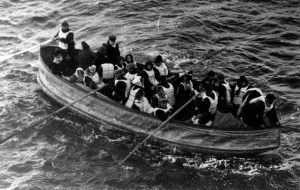 Miscellaneous
Miscellaneous  Miscellaneous
Miscellaneous  Politics
Politics 10 Lesser-Known Far-Right Groups of the 21st Century
 History
History Ten Revealing Facts about Daily Domestic Life in the Old West
 Weird Stuff
Weird Stuff 10 Everyday Products Surprisingly Made by Inmates
 Movies and TV
Movies and TV 10 Actors Dragged out of Retirement for One Key Role
 Creepy
Creepy 10 Lesser-Known Shapeshifter Legends from Around the World
 Animals
Animals 10 Amazing Animal Tales from the Ancient World
 Gaming
Gaming 10 Game Characters Everyone Hated Playing
 Books
Books 10 Famous Writers Who Were Hypocritical
 Humans
Humans 10 of the World’s Toughest Puzzles Solved in Record Time
 Miscellaneous
Miscellaneous 10 Ironic News Stories Straight out of an Alanis Morissette Song
 Politics
Politics 10 Lesser-Known Far-Right Groups of the 21st Century
 History
History Ten Revealing Facts about Daily Domestic Life in the Old West
Who's Behind Listverse?

Jamie Frater
Head Editor
Jamie founded Listverse due to an insatiable desire to share fascinating, obscure, and bizarre facts. He has been a guest speaker on numerous national radio and television stations and is a five time published author.
More About Us Weird Stuff
Weird Stuff 10 Everyday Products Surprisingly Made by Inmates
 Movies and TV
Movies and TV 10 Actors Dragged out of Retirement for One Key Role
 Creepy
Creepy 10 Lesser-Known Shapeshifter Legends from Around the World
 Animals
Animals 10 Amazing Animal Tales from the Ancient World
 Gaming
Gaming 10 Game Characters Everyone Hated Playing
 Books
Books 10 Famous Writers Who Were Hypocritical
 Humans
Humans 10 of the World’s Toughest Puzzles Solved in Record Time
10 Things You May Not Know about the Titanic Disaster
Nearly everyone on Earth has heard about the legendary ship Titanic. It was a British passenger liner operated by White Star Line, sinking in the North Atlantic Ocean on April 15, 1912, after striking an iceberg on her maiden voyage. The RMS Titanic was sailing from Southampton, England, to New York City. Throughout much of the voyage, the wireless radio operators aboard the ship received iceberg warnings. Unfortunately, it couldn’t avoid a collision with an iceberg. These are ten things you may not know about the Titanic disaster:
Related: 10 Creepy Premonitions About The Sinking Of The Titanic
10 One Ship Musician Wasn’t Declared Dead Until 2000

The Titanic was a highly-regarded ship, being the largest ship afloat when it was constructed. The shipbuilders had high-society passengers in mind when constructing the ship. So a ship with the richest man in the world on board would definitely have musicians.
One of the musicians on board was Roger Marie Bricoux, who died alongside other musicians in the sinking. Unfortunately, France received no record of his death, and in 1913, the French Army regarded him as a “deserter” because of his “disappearance.” In fact, Bricoux was not declared dead until the year 2000. [1]
9 The Band Went Down Playing Music
While the aristocrats that were on board the Titanic have been at the center of much of the history of the tragedy, there is a lesser-known true story of an unforgettable incident that took place at the time of the sinking. When the ship struck the iceberg in the early hours of April 15, Wallace Hartley, an English violinist and the bandleader, brought together his orchestra, which made their way to the main deck where they entertained the panic-stricken passengers.
The band did not stop playing even as the ship split in half, and people were getting swept violently into the waters. They kept it up until the end when the engulfing ocean drowned them. No member of the band survived the sinking. Their bravery, dedication, and sacrifice will always be remembered in the narrative of the ship’s tragic tale.[2]
8 A Titanic Survivor Also Survived the Britannic
The Titanic was just one of three Olympic-class ocean liners built by the Harland & Wolff shipyard for the White Star Line. All three were built with one objective in mind: They were designed to give White Star Line an edge in the transatlantic passenger shipping trade by being the largest and most luxurious passenger ships at the time. Although the Olympic managed to have a career spanning 24 years and was retired and sold for scrap, the Titanic and the Britannic encountered disasters.
An Irish nurse named Violet Jessop was 28 years old when the Britannic sunk off the coast of Greece on the Aegean Sea after it hit a German mine. In an attempt to escape what was imminent, Violet leaped into the water and was sucked under the ship’s keel. She suffered a blow to her head from the propellers, but she claimed she managed to survive the injury because of her thick hair. This case would seem like an ordinary survival incident except for the fact that Violet Jessop was also aboard the Titanic when it hit an iceberg and sank. She was lucky enough to get a place on one of the lifeboats and was one of the 710 passengers rescued by the Carpathia.[3]
7 A Rumor Claimed a Man Escaped the Sinking by Dressing as a Woman

Every significant incident will likely be followed by legends; human experience has taught us this, and the story of Titanic is not an exception. Legend has it that an adult male passenger was able to survive the sinking of the Titanic by dressing up as a woman. During the rescue effort after Titanic hit the iceberg, the rescuers followed the social imperative of women and children first. But then, it became imminent that the Titanic was going to sink.
So, it’s logical that a man who wanted to escape the sinking may need to dress up as a woman. The man suspected to have done this was William T. Sloper of New Britain, Connecticut. He was publicly shamed in a New York newspaper as “the man who got off in a woman’s clothing.” In reality, Sloper escaped the sinking in the very first lifeboat launched. This is because when Sloper got a seat on the lifeboat, many of Titanic’s passengers were yet to comprehend the direness of the situation, and very few were willing to sit on a lifeboat in the open sea. By the time the gravity of the situation became known to all aboard the Titanic, Sloper was already in a lifeboat.[4]
6 1958 Film Had Survivor Try to Symbolically Go Down with the Ship
Lawrence Beesley was a second-class passenger on the Titanic. He was in his cabin (D-56) when the ship collided with an iceberg. When Beesley noticed some unusual things, he stopped a steward to ask what had happened, but the steward responded that there was nothing unusual. However, Beesley did not believe this. He went to the A-Deck to investigate but somehow missed the whole incident. So he decided to return to his cabin.
As he tried to descend the stairs, he noticed that despite the stairs appearing to be level, his feet missed and did not land where they were supposed to. He returned to the A-Deck and, this time, realized what was happening. He was able to escape in a lifeboat.
Having survived the disaster, Beesley wrote a successful book, The Loss of the S.S. Titanic, about his experience. And Beesley would also be remembered for an incident during the filming of the movie A Night To Remember,” a movie about the Titanic incident.
When the sinking scene was being filmed, Beesley—who was in attendance at the filming—made an attempt to drown himself in order to symbolically “go down with the Titanic ship.” However, the director of the movie, Roy Ward Baker, did not allow this to happen because of the consequences.[5]
5 Half of One School’s Students Lost Their Fathers
The news of the sinking of the Titanic was devastating to the whole world. However, there was no city in the world that was more devastated by the news of the Titanic disaster than the port city of Southampton. The scenes in some parts of the town were heartwrenching when the news broke in Southampton. Nearly a thousand families were concerned by the fate of the crew alone. In most cases, the sole breadwinner of each of the families were the ones involved in the disaster. In fact, in one school in Northam, Southampton, 120 of the 240 pupils lost their fathers in the disaster.[6]
4 Ship Used in Filming a Titanic Movie Also Sank
There are quite a few movies about the Titanic disaster. During World War II, the Nazis came up with a grand plan to humiliate Britain. The idea was to make a movie about the sinking of the Titanic from a perspective that would look as if the British were careless and wicked and that their greed led to the tragedy. The movie is titled Titanic (1943) and is popularly known as “The Nazi Titanic.”
The script of the movie was written by German screenwriter Harald Bratt. Goebbels was in charge of bringing the propaganda movie to reality, and at the time, it was the most expensive movie ever made. Production of the movie started in September 1941. From the opening scene to the boardroom of the Titanic, the villains of the movie were the immoral British capitalists who were not interested in the lives of the people on board but in the profit that they stood to make if they could race the ship across the Atlantic in record time.
The director of the movie demanded a full-size ocean liner that he could film on, and the Nazis provided the Cap Arcona, which was Germany’s own version of a luxury ocean liner. Tragically and ironically, toward the tail end of the Second World War, the Cap Arcona was sunk by RAF Typhoon Fighter Bombers.[7]
3 Titanic (1997) Film Was More Expensive Than the Actual Ship
The Titanic movie was the most expensive movie ever made at the time of its release. The movie gulped $210 million, which is $337 million in today’s money. On the other hand, it cost $7.5 million to build the RMS Titanic—$200 million in today’s money.
In addition, the Titanic ship and the Titanic movie had certain similarities. When construction was completed, the Titanic was the most luxurious ship afloat. The same goes for the Titanic movie, as the most expensive movie ever made when it was released. Their fate was, however, different. While the Titanic sank on its maiden voyage leading to monumental financial losses, the Titanicmovie has gone on to gross $2.2 billion and was the first movie to pass the $1 billion mark.[8]
2 A Woman Died Because She Refused to Leave Her Dog Behind
Ann Elizabeth Isham was a passenger aboard the Titanic. She was one of five female first-class passengers to die when the ship sank. It is believed that Ann had already secured a place on one of the lifeboats that rescued passengers, but she jumped out as soon as she was informed that her dog, a Great Dane, would not join her. Days later, a recovery ship found the body of a woman clinging to a large dog, and all accounts believe that it was Ann Elizabeth Isham and her beloved Great Dane.[9]
1 Whiskey Saved a Survivor of the Titanic
Charles Joughin was born in 1878 and was a chef from Birkenhead who served as a chief baker on the Titanic. When the ship hit the iceberg, Joughin helped move women and children onto Lifeboat 10. Despite the fact that he was assigned as the captain of Lifeboat 10, he did not board it but instead returned to his quarters and consumed whiskey, water flooding at his feet.
Later that day, Joughin would be remembered for his astonishingly long survival time in icy waters, as there was no space for him on any other lifeboat, so he survived by holding on to the edges of a lifeboat while half of his body was submerged in water. It is believed that the large amount of whiskey he consumed boosted his courage and reduced the fear and panic that could make a man succumb to such a negatively overwhelming situation.[10]








